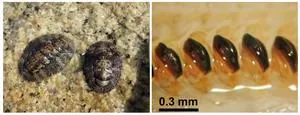
Revolutionizing Genome Editing: Scientists Harness Bacterial Defense Mechanism for Precision DNA Tagging
2025-09-18
Author: Wei Ling
A Game-Changer in Genetic Engineering
In an exciting breakthrough, a research team from the Helmholtz Institute for RNA-based Infection Research (HIRI) has unveiled a pioneering method for editing genetic material that could reshape fields like medicine, agriculture, and biotechnology. Their findings, published in Nature Biotechnology, showcase a novel technique that attaches chemical markers directly to DNA, allowing for unprecedented precision in genome editing.
The Evolution of Genetic Tools
Recent years have seen whirlwind advancements in genetic editing technologies. CRISPR-Cas9, often referred to as "gene scissors," and base editing—capable of making pinpoint changes to DNA without causing cuts—have emerged as essential tools in clinical and agricultural research. These innovations are currently being harnessed to treat genetic disorders, enhance crop durability, and even engineer bacteria for various applications.
Inspired by Nature: The Tackling of Viruses
At HIRI, scientists partnered with teams from Julius-Maximilians-Universität Würzburg, North Carolina State University, and ETH Zurich. They sought to refine DNA editing techniques in bacteria, plants, and human cells. Their inspiration? A natural bacterial defense mechanism against viruses, specifically bacteriophages. Bacteria deploy two key enzymes, DarT2 and DarG, which work together to fend off viral threats. DarT2 attaches a chemical marker to the DNA during a viral invasion, effectively blocking replication and curbing the virus's spread.
Introducing 'Append Editing'
When there's no immediate threat, DarG steps in to deactivate DarT2 and removes the marker, ensuring the virus doesn’t spread. This finely-tuned mechanism has inspired what researchers are calling "append editing"—a groundbreaking method that allows for genetic modifications previously deemed impossible. According to the researchers, this technique marks a significant leap forward in genome editing.
How It Works: A New Layer of Precision
Think of DNA as a long chain of letters in a notebook. Traditional editing methods remove or swap letters, but append editing introduces a small chemical group—ADP-ribose molecules—like a "sticky note" attached to a specific letter. This marker persuades the cell to alter the DNA with high accuracy while causing minimal disruption.
Varied Effects Across Organisms
Unlike existing tools that yield similar results across all organisms, the impact of append editing varies dramatically between bacteria and more complex eukaryotes like plants, fungi, and human cells. Chase Beisel, affiliated department head at HIRI, noted, "We discovered that append editing could lead to substantial modifications in bacteria based on a template, while in eukaryotic cells, the modified DNA base actually changes identity." This revelation about differing DNA repair outcomes across organisms has captivated researchers.
Unlocking New Possibilities
Researchers are optimistic about the potential applications this new tool promises. "Append editing significantly broadens the genetic research toolkit, opening new avenues for precision biotechnology and medical therapies," states doctoral student Darshana Gupta. Imagine tailoring microbes to optimize beneficial bacteria in the human body or facilitating a deeper understanding of pathogens.
Looking Ahead: The Future of Gene Editing
While further research is essential before these applications make their way into clinical settings, the scientific community is hopeful. As Harris Bassett, a Ph.D. candidate at HIRI, puts it, "DarT2 exemplifies the powerful potential of leveraging bacterial defenses in genetic research." This innovative approach could be the key to solving some of the most pressing challenges in modern medicine and agriculture.



 Brasil (PT)
Brasil (PT)
 Canada (EN)
Canada (EN)
 Chile (ES)
Chile (ES)
 Česko (CS)
Česko (CS)
 대한민국 (KO)
대한민국 (KO)
 España (ES)
España (ES)
 France (FR)
France (FR)
 Hong Kong (EN)
Hong Kong (EN)
 Italia (IT)
Italia (IT)
 日本 (JA)
日本 (JA)
 Magyarország (HU)
Magyarország (HU)
 Norge (NO)
Norge (NO)
 Polska (PL)
Polska (PL)
 Schweiz (DE)
Schweiz (DE)
 Singapore (EN)
Singapore (EN)
 Sverige (SV)
Sverige (SV)
 Suomi (FI)
Suomi (FI)
 Türkiye (TR)
Türkiye (TR)
 الإمارات العربية المتحدة (AR)
الإمارات العربية المتحدة (AR)